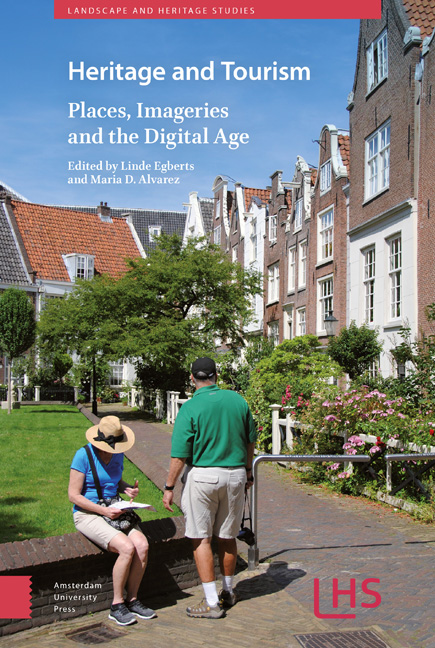Book contents
- Frontmatter
- Dedication
- Contents
- List of Figures and Tables
- Foreword
- 1 Tourism and Heritage: Crafting Experiences Through Innovation
- 2 Tourism Conflicts and Conflict Tourism: Curating “Holoscapes” in Europe’s Age of Crisis
- 3 Heritage Landscapes of Hiroshima and Nagasaki
- 4 Revealing and Presenting the Past(s) for the Public: Fethiye Mosque and Museum as a Cultural Heritage Site in Istanbul
- 5 Who Takes the Lead in Initiating Cooperation in a Cultural Network and Why?: The case study of a Rural Finnish Destination
- 6 Sustainability of Heritage-Tourism Destinations: A Demand-Based Perspective on Cusco, Peru
- 7 Localising National Tourism Websites: The case of World Heritage sites
- 8 Enhancing the Tourist Heritage Experience through “In-Situ”, Customisable, 3D-Printed Souvenirs
- 9 Tracking the Heritage Tourist: Heritage tourism and Visiting Patterns in a Historic City
- 10 The Construction of a Tourist-Historic Icon: The case of the Palace of Westminster, London
- 11 Conclusion
- Index
10 - The Construction of a Tourist-Historic Icon: The case of the Palace of Westminster, London
Published online by Cambridge University Press: 22 December 2020
- Frontmatter
- Dedication
- Contents
- List of Figures and Tables
- Foreword
- 1 Tourism and Heritage: Crafting Experiences Through Innovation
- 2 Tourism Conflicts and Conflict Tourism: Curating “Holoscapes” in Europe’s Age of Crisis
- 3 Heritage Landscapes of Hiroshima and Nagasaki
- 4 Revealing and Presenting the Past(s) for the Public: Fethiye Mosque and Museum as a Cultural Heritage Site in Istanbul
- 5 Who Takes the Lead in Initiating Cooperation in a Cultural Network and Why?: The case study of a Rural Finnish Destination
- 6 Sustainability of Heritage-Tourism Destinations: A Demand-Based Perspective on Cusco, Peru
- 7 Localising National Tourism Websites: The case of World Heritage sites
- 8 Enhancing the Tourist Heritage Experience through “In-Situ”, Customisable, 3D-Printed Souvenirs
- 9 Tracking the Heritage Tourist: Heritage tourism and Visiting Patterns in a Historic City
- 10 The Construction of a Tourist-Historic Icon: The case of the Palace of Westminster, London
- 11 Conclusion
- Index
Summary
Abstract
In this chapter we will assess the historical process by which the popularity of urban heritage attractions is constructed, based on the example of one of these famous tourist-historic icons, as we call them. We will examine this process from both a historical and a spatial perspective. The Palace of Westminster in London with its world-famous Big Ben clock serves as a case study. The main question of this chapter is: What is the relationship between the history of heritage sites and their sacralisation as tourist-historic icons, as illustrated by the Palace of Westminster in London? The development of the Palace of Westminster as a heritage site has resulted in a dynamic, but also consistent image over the course of the centuries, also during the rise of mass tourism and mass media. Based on MacCannell's model of sacralisation of tourist attractions, we trace the five phases in the process of becoming a tourist-historic icon, ranging from naming, framing & elevation, and enshrinement, to mechanical reproduction and social reproduction. Our case study shows that the sacralisation process MacCannell describes does not exist separately from the heritagisation of historic sites. It shows that a site with a complex layering of historic, political, symbolic, and cultural meanings may reflect all five phases, though not in a linear order. We show how intertwined the historical development of this site is with its more recent sacralisation as a tourist attraction. The narratives and values that are communicated by markers like travel guides, films, and images on social media convey the image of the palace as the centre of a well-organised empire and of Britishness. These values were not invented for the purpose of attracting tourists. Rather, the narrative of the Palace of Westminster as a tourist-historic icon confirms and builds upon the values long associated with the site.
Keywords: tourist-historic icon, MacCannell, World Heritage, Palace of Westminster
Introduction
Urban centres have been a focal point for travellers since the early days of tourism, starting with medieval pilgrimages to important religious centres such as Rome. Then, from the late seventeenth century onwards, the Grand Tour became popular: an educational tour through Europe encompassing the highlights of (mainly classical) Western art and culture. Initially, only young noblemen made these tours, but beginning in the eighteenth century it also became a popular practice among the wealthy bourgeoisie (Urry, 2011, p. 4-5).
- Type
- Chapter
- Information
- Heritage and TourismPlaces, Imageries and the Digital Age, pp. 193 - 214Publisher: Amsterdam University PressPrint publication year: 2018



